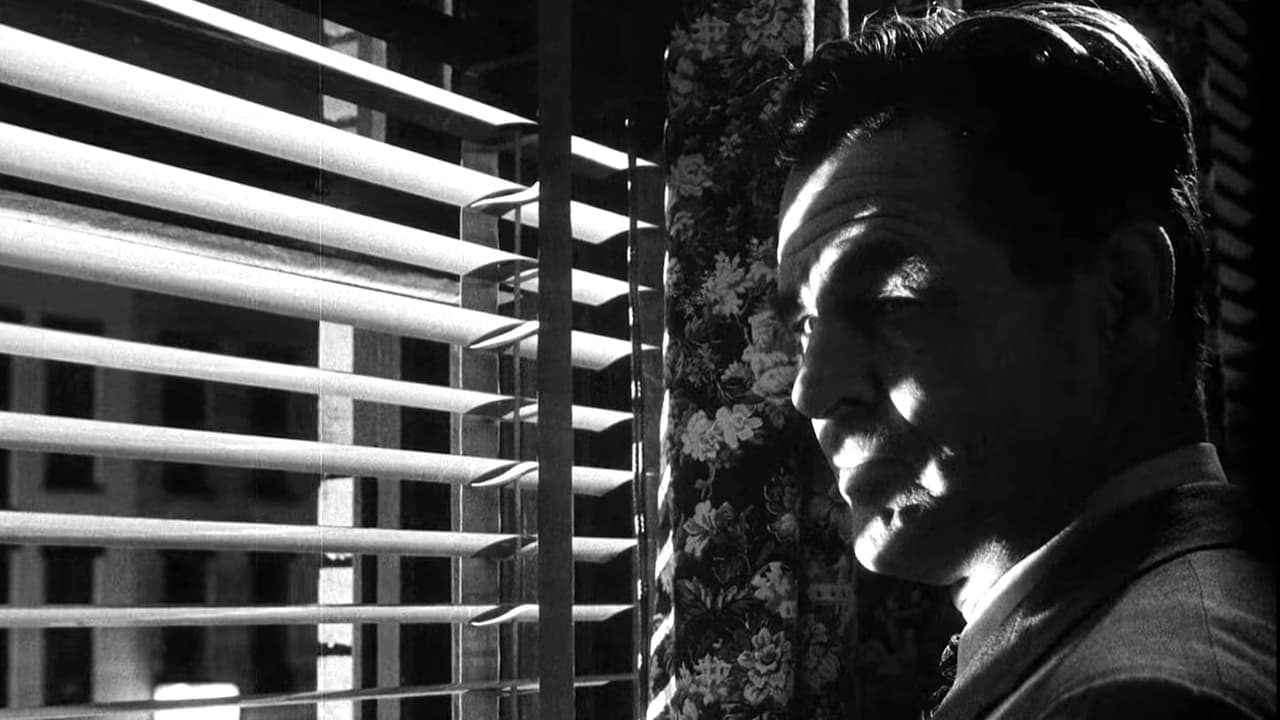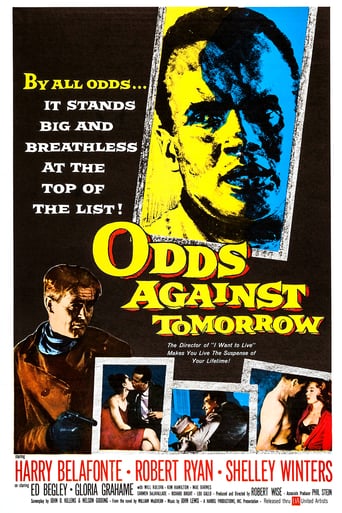

In New York, the former cop Dave Burke (Ed Begley) summons the veteran Earle Slater (Robert Ryan) and the jazz musician Johnny Ingram (Harry Belafonte) to heist a bank in a small town. Slater is financially supported by his woman Lorry (Shelley Winters) and feels uncomfortable with the situation. Johnny is a compulsive gambler and owes a large amount to the shark Bacco (Will Kuluva), who is threatening his ex-wife and his daughter. They both are reluctant to accept the invitation, but they need money and accept to participate in Burke's plan. However Slater is racist and does not trust in Johnny."Odds against Tomorrow" is a suspenseful crime drama with the story of the preparation and execution of a heist of a bank. Directed by Robert Wise and with magnificent performance of Robert Ryan, the plot discloses the racism in America in 1959. The racial tension between the characters performed by Robert Ryan and Harry Belafonte is increasing reaching the climax in the tragic conclusion. My vote is seven.Title (Brazil): Not Available on Blu-Ray or DVD.
... View MoreOdds Against Tomorrow is directed by Robert Wise and adapted to screenplay by Abraham Polonsky and Nelson Gidding from the novel written by William P. McGivern. It stars Harry Belafonte, Robert Ryan, Ed Begley, Shelley Winters and Gloria Grahame. Music is by John Lewis and cinematography by Joseph C. Brun. Don't beat on that Civil War jazz here Slater. We are all in this together - each man equal. And we're taking care of each other, it's one big play, our one and only chance to grab sticks forever. And I don't wanna hear bout what your Grandpappy thought on the old farm down on old Oklahoma. You got it? A seething ball of fatalism, pessimism and racism, Odds Against Tomorrow packs a firm handed noir punch. At the core it's a tale of 3 men doing a heist, each man with their own reasons for breaking the law, to tackle what looks to be a simple job. Begley is a bitter ex-cop, Ryan a loser living off of his girlfriend, and Belafonte likes to gamble on the horses, only he's not very good at it and now his financial provider wants cashing in - or there are bigger prices to be paid... All men are evil. Wise is in no hurry here, he builds the characters and inner turmoil of each protagonist for a good portion of the running time. It's a good move. The racial tension is palpable, Earle Slater (Ryan) is a venomous racist, which obviously doesn't go down too well with Johnny Ingram (Belafonte), their scenes together crackle with electric tinged hatred, which in turn gives the whole pic its ism factors. It's bitter stuff, further compounded by the two femmes of the piece, both of whom are attached to Slater. They are not fatale types, but Lorry (Winters) and Helen (Grahame) are sad cases for differing reasons, both adding to the all round sourness of the narrative, with Helen's key scene with Slater containing razor edged scripting. Hello dear! The makers fill out the pic with an array of noir standards, from gay henchmen, facially blemished bystanders and acerbic dialogue, to a whole bunch of scenes and imagery that linger large. Daylight scenes have a threatening hue to them, most often boosted by crafty images such as deflated balloons, a battered doll, a rusty old tin can, a dizzying carousel or even a serene shot of a rabbit caught in the sights of our most hate filled protag. Brun's night photography out in the streets is rich with oppressive and ominous atmosphere, and the interior environments of a cramped apartment (scary stairs outside of course) and a smoky club (hello percussion abuse!) are ripe with a claustrophobic hopelessness befitting the story. And all the time John Lewis lays some sumptuously moody jazz over everything. It all builds to the big finale, the heist and the heart tugs, a welcome to noirville sign going blink blink blinkity blink somewhere in the shadowed city. The message is clear, and every lover of film noir owes Robert Wise a debt of gratitude for overseeing a change of endings from the literary source. Yes, even the director of two of the most popular musicals of all time could beat a black heart. Thank you Bobby. 9/10
... View MoreIt is the Winter of Discontent that surrounds this Film-Noir that many call the "Final Entry" (although this is subjective) in the Genre. The Characters are all in their Last Season before the End. Racial Tensions Contemporaneously were reaching the Terminal Point of No Return. This Movie is a Bleak and Cold Combination of this Profound Predicament and it is a Pulse Ppounding Picture that Compromises very Little.Some say the Ending is Heavy Handed and the Ticking Time Bomb that got Us there was going to End in nothing less than an Explosion. That leads to the Underlying Message that if the Racism wasn't at hand, these Fellow Travelers would have gotten away with it. There is an Awesome Opening Credit Sequence that is a Surreal Display of Patterns and Movement with an underlying Jazz Motif that would Haunt the rest of the Film. A Crisp Look with an Edge that cuts from the City and moves to the Country, this Powerful, Poetic Story is one from the Recesses of the Psyche that takes up Residence in all Losers and People on the Fringe Fighting to Gain some Respect in a World that has None to Offer, so They have to Take it. This is one of the Fifties True Noirs that could be called a Fitting End to a Cycle that will be Adopted by a New Generation of Directors who saw that there certainly would be No End to the Types of People that Inhabited the Noir Universe and the only thing that really was going to Change was the Genre's Title. For the most part the Genre would Include Nothing New but Henceforth would be called Neo-Noir.
... View MoreWhile many have stated that Orson Welles's Touch of Evil is the final film noir, or first neo-noir, the same can be said for this film. A true hidden gem that was directed by the vastly underrated, and versatile, Robert Wise. The black and white images are actually punctuated by the two main characters, Robert Ryan (excellant!) and Harry Bellafonte (excellant as well!). As this film can border the old school noir, it also walks the thin line of the neo-noir. Race is a very intrigual part of this film and though themes of it were evident in Touch of Evil, here it is in your face like the afternoon school bully. Ryan, as much of a professional as he is, can not seem to get over the fact that one of his partners in his latest job is a black man. Bellafonte's character is not only a highly recommended professional capable of being Ryan's peer, but he is also dating a white woman! This was also before the subject was put in motion by Guess Who's Coming to Dinner?. But race relations aside, this movie has the typical noir characteristics of: black and white cinematography, crime, criminals knowing that this may be their demise, love that will not last, greed, and double crosses. But like Touch of Evil as well, this makes good use of being a genre defining desert noir that I have commented on before. The final scene is just as literal as James Cagney's farewell in White Heat and on par as the final punctuation as the fore-mentioned film. Seek out on: video, DVD, TV, TiVo, whatever and see how this movie not only ended one genre and started another, but also see how this film could've been considered one of the catalyst films that might've sparked the Civil Rights movement (another thing that Bellafonte was involved in as well; this guy has his hands in every pie).
... View More